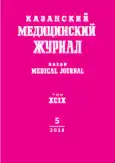Clinical and immunological characteristics of patients with chronic hepatitis C during antiviral therapy in interferon-free regimen
- Authors: Basina VV1, Sukhoruk AA1,2, Arsentieva NA2, Lyubimova NE2, Semenov AV2, Esaulenko EV1,2, Totolyan AA2
-
Affiliations:
- Saint Petersburg State Pediatric Medical University
- Saint-Petersburg Pasteur Research Institute of Epidemiology and Mictobiology
- Issue: Vol 99, No 5 (2018)
- Pages: 760-765
- Section: Theoretical and clinical medicine
- URL: https://journals.rcsi.science/kazanmedj/article/view/10298
- DOI: https://doi.org/10.17816/KMJ2018-760
- ID: 10298
Cite item
Full Text
Abstract
Aim. To study the biomarkers of liver inflammation that occur during antiviral therapy in the interferon-free regimen.
Methods. 14 patients were examined during antiviral therapy of chronic viral hepatitis C genotype 1. Treatment with dasabuvir, ombitasvir, paritaprevir and ritonavir for 12 weeks was received by 8 patients. Daklatasvir and asunaprevir was administered to 6 patients for 24 weeks. 11 patients had the concentrations of cytokines/chemokines (TNFα, CCL2/MCP-1, CCL20/MIP-3α, CXCL9/MIG, CXCL10/IP-10, CXCL11/ITAC) measured in the blood plasma by multiplex analysis. In six patients, the content of CXCR3+ and CCR6+ receptors in different subpopulations of lymphocytes was determined by flow cytofluorimetry. Patients were divided into 2 groups: without liver fibrosis and with severe fibrosis.
Results. 100% demonstrated virologic response. In both groups, significant reduction of CXCL10/IP-10 concentration was found in the patients at the end of treatment compared to pre-therapy (p=0.025 and 0.00015, respectively). In the first group a tendency to increase of the relative content of T-lymphocytes (p=0.065) was observed, and in the second group, a significant increase of the relative content of TNKCCR6+ (p=0.02) was observed.
Conclusion. Chemokine CXCL10/IP-10 is a biomarker characterizing the decrease of liver inflammation during therapy and not depending on the degree of liver fibrosis. The tendency to increase of the relative content of T lymphocytes in the first group and a significant increase in TNKCCR6+ cells during treatment in the second group may play an important role in eliminating hepatitis C virus.
Full Text
##article.viewOnOriginalSite##About the authors
V V Basina
Saint Petersburg State Pediatric Medical University
Author for correspondence.
Email: v.basina@mail.ru
Saint-Petersburg, Russia
A A Sukhoruk
Saint Petersburg State Pediatric Medical University; Saint-Petersburg Pasteur Research Institute of Epidemiology and Mictobiology
Email: v.basina@mail.ru
Saint-Petersburg, Russia; Saint-Petersburg, Russia
N A Arsentieva
Saint-Petersburg Pasteur Research Institute of Epidemiology and Mictobiology
Email: v.basina@mail.ru
Saint-Petersburg, Russia
N E Lyubimova
Saint-Petersburg Pasteur Research Institute of Epidemiology and Mictobiology
Email: v.basina@mail.ru
Saint-Petersburg, Russia
A V Semenov
Saint-Petersburg Pasteur Research Institute of Epidemiology and Mictobiology
Email: v.basina@mail.ru
Saint-Petersburg, Russia
E V Esaulenko
Saint Petersburg State Pediatric Medical University; Saint-Petersburg Pasteur Research Institute of Epidemiology and Mictobiology
Email: v.basina@mail.ru
Saint-Petersburg, Russia; Saint-Petersburg, Russia
A A Totolyan
Saint-Petersburg Pasteur Research Institute of Epidemiology and Mictobiology
Email: v.basina@mail.ru
Saint-Petersburg, Russia
References
- World Health Organization. Hepatitis C. Key facts. http://www.who.int/news-room/fact-sheets/detail/hepatitis-c (access date: 18.06.18).
- Angeli P., Bernardi M., Villanueva C. et al. European Association for the Study of the Liver. EASL Clinical Practice Guidelines: management of patients with decompensated cirrhosis. J. Hepatol. 2018; 69 (2): 406–460. doi: 10.1016/j.jhep.2018.03.024.
- Esaulenko E.V., Vysochinskaya V.V., Nikitina O.E. The effectiveness of combined antiviral therapy in patients with chronic hepatitis C, 1B genotype with various degrees of fibrosis. Zhurnal infektologii. 2012; 4 (3S): 75. (In Russ.)
- Maevskaya M.V., Ivashkin V.T., Znojko O.O. at el. Efficacy and safety of the national inhibitor of Narlaprevir protease in primary and previously treated patients with chronic hepatitis C caused by the 1st genotype virus, without liver cirrhosis (results of the Pioneer study). Rossijskij zhurnal gastroehnterologii, gepatologii, koloproktologii. 2017; 27 (6): 41–51 (In Russ.)
- Ivashkin V.T., Maevskaya M.V., Аbdurakhmanov D.T. et al. Modern possibilities of antiviral therapy using Daclatasvir in the treatment of patients with chronic viral hepatitis C: results of the individual access program. Rossijskij zhurnal gastroehnterologii, gepatologii, koloprotologii. 2017; 27 (6): 52–62. (In Russ.)
- Lin J.C., Habersetzer F., Rodriguez-Torres M. et al. Interferon γ-induced protein 10 kinetics in treatment-naive versus treatment-experienced patients receiving interferon-free therapy for hepatitis C virus infection: implications for the innate immune response. J. Infect. Dis. 2014; 210 (12): 881–885. doi: 10.1093/infdis/jiu325.
- Bility M.T., Nio K., Li F. et al. Chronic hepatitis C infection-induced liver fibrogenesis is associated with M2 macrophage activation. Sci. Rep. 2016; (6): 39520. doi: 10.1038/srep39520.
- Kazankov K., Barrera F., Moller H.J. et al. Soluble CD163, a macrophage activation marker, is independently associated with fibrosis in patients with chronic viral hepatitis B and C. Hepatology. 2014; 60 (2): 521–530. doi: 10.1002/hep.27129.
- Sandler N.G., Koh C., Roque A. et al. Host response to translocated microbial products predicts outcomes of patients with HBV or HCV infection. Gastroenterology. 2011; 141 (4): 1220–1230. doi: 10.1053/j.gastro.2011.06.063.
- Askarieh G., Alsio A., Pugnale P. et al. Systemic and intrahepatic interferon-gamma-inducible protein 10 kDa predicts the first-phase decline in hepatitis C virus RNA and overall viral response to therapy in chronic hepatitis C. Hepatology. 2010; 51: 1523–1530. doi: 10.1002/hep.23509.
- Prinapori R., Sticchi L., Alicino C. et al. Role of HCV-RNA decay and IP-10 levels after 48 hours of standard HCV therapy as predictors of rapid virological response. Clin. Res. Hepatol. Gastroenterol. 2015; 39: 705–710. doi: 10.1016/j.clinre.2015.04.001.
- Mascia C., Vita S., Zuccalà P. et al. Changes in inflammatory biomarkers in HCV infected patients undergoing direct acting antiviral-containing regimens with or without interferon. PLoS ONE. 2017; 12 (6): e0179400. doi: 10.1371/journal.pone.0179400.
- Serti E., Chepa-Lotrea X., Kim Y. J. et al. Successful Interferon-Free Therapy of Chronic Hepatitis C Virus Infection Normalizes Natural Killer Cell Function. Gastroenterology. 2015; 149 (1): 190–200. doi: 10.1053/j.gastro.2015.03.004.
- Diago C. M., Castellano G., GarcoAa-Samaniego J. et al. Association of pretreatment serum interferon gamma inducible protein 10 levels with sustained virological response to peginterferon plus ribavirin therapy in genotype 1 infected patients with chronic hepatitis. Gut. 2006; 55 (3): 374–379. doi: 10.1136/gut.2005.074062.
Supplementary files






